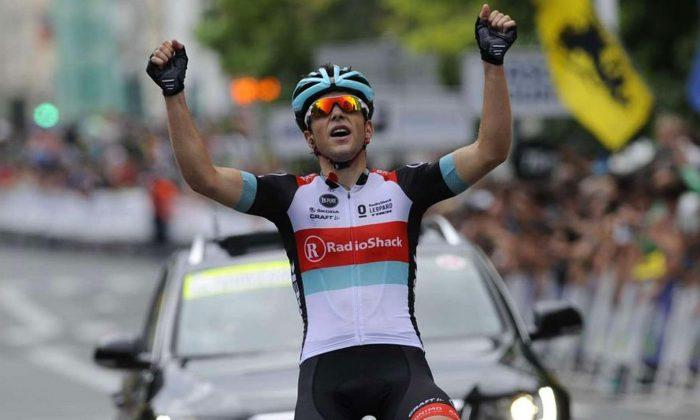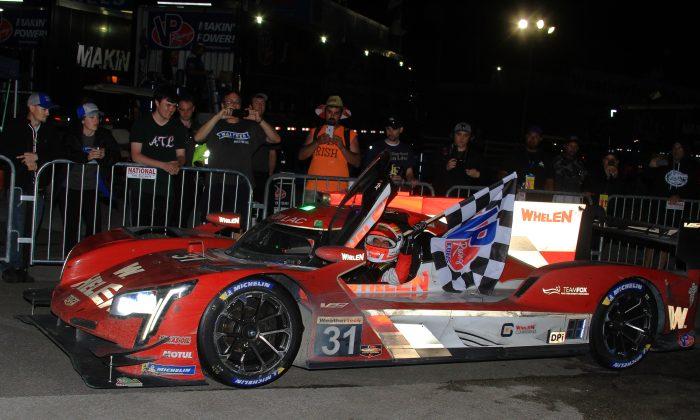RadioShack’s Tony Gallopin scored the biggest win of his career with a solo attack on the final climb of Saturday’s Clásica Ciclista San Sebastián cycling race.
The 25-year-old French attacked a group of 13 riders on the Cat Two Alto de Arkale, sixteen km from the finish of the 234-km race. A powerful five-rider chase group—Roman Kreuziger and Nicolas Roche (Saxo-Tinkoff,) Mikel Landa (Euskaltel-Euskadi,) and former winner Alejandro Valverde (Movistar)—couldn’t catch the flying Frenchman.
Possibly the chasers underestimated Gallopin, who was seen more as a second-tier sprinter before this win. Valverde and Kreuziger in particular were considered favorites, both coming off excellent performances in the Tour de France.
Mikel Landa also was very motivated; his Euskaltel Euskadi team is losing funding next season and desperately needed a win, and a win in the team’s home race—which it had never won in the race’s 33-year existence—would have been about the best possible.
Not this time. Landa lost touch with the chasers 3.5 km from the finish, and the remaining four lacked the firepower to catch Gallopin, who won by 28 seconds.
Tony Gallopin: “I already felt good on the Jaizkibel and then on the Arcale I could feel I was still good,” Gallopin said on the team website.
“As I knew (team mate) Bob Jungels was coming back I didn’t dare attack but Alain [Team Director Alain Gallopin] gave me the green light.
“I was so tired after the Tour de France and even disappointed because I couldn’t win a stage. But this morning I immediately knew that I had super good legs,” he continued.
“I like the one-day races but this is the first time I’ve done this race so it was really new for me. But I’m so happy. To be here on the podium with Valverde and Kreuziger means a lot to me.”
Alejandro Valverde beat out Roman Kreuziger by a few inches in the sprint for second place, but that was a pale consolation prize for the 33-year-old Spaniard, who wanted a win here to offset his bad luck in the Tour de France. Canondale’s Moreno Moser took third.
Basque Country Classic
Clásica Ciclista San Sebastián winds through the hilly Basque region straddling the border between Spain and France. Pais Vasco lies between two arms of the Basque mountain range; San Sebastián, near the Atlantic coast, is one of the region’s bigger cities.
The Clásica Ciclista San Sebastián comes late in the season, between two Grands Tours, unlike most of the Belgian one-Day Classics which can be used as early-season warm-ups.
Like the Belgian Classics, Spain’s San Sebastián is long, at 232 km, and features a lot of low hills as opposed to any truly alpine climbs. Because of the pace and the length, even these smaller climbs can make selections, though.
Unlike the Belgian Classics, San Sebastian is usually sunny. This year, however, the day was gray and rain near the finish made the final descents more dangerous.
The two toughest climbs of San Sebastián are the Cat One Alto de Jaizkibel—over seven km at 5.84 percent—and the Cat Two Alto de Arkale, 2.7 km at 6.3 percent. Both hills were climbed twice in the final 75 km of the race.
An early break (Olivier Kaisen (Lotto Belisol,) Luca Wackermann (Lampre-Merida,) Matthias Krizek (Cannondale,) and Francisco Aramendia (Caja Rural)) opened an eleven-minute gap, but were caught and passed by a chase group lead by Movistar’s Nairo Quintana and Alejandro Valverde on the second ascent of Jaizkibel with 40 km left to go in the race.
The Movistar riders really pushed the pace on the climb, looking to drop as many riders as possible to set up Valverde’s final charge for the win.
A group of eight chasers formed on the descent from Jaizkibel—Roman Kreuziger and Nicolas Roche (Saxo-Tinkoff,) Mikel Landa (Euskaltel-Euskadi,) Tony Gallopin (RadioShack,) Alejandro Valverde (Movistar,) Arnold Jeannesson (FDJ,) Moreno Moser (Canondale,) and Yannick Eijssen (BMC.)
Two more riders—Mikel Asterloza (Euskaltel,) and Sylvain Chavanel (Omega Pharma-Quickstep) joined the chase with 25 km to go, and three more—Mikel Neive (Euskaltel,) Peter Serry (Omega,) and Bob Jungels (RadioShack)—bridged to the leaders at the base of the final climb up Arkale.
All the favorites watched each other closely on the climb. They all knew that Valverde, without any teammates in the group, would need to attack—with Saxo, Euskaltel, and Omega all with multiple riders in the group, Valverde was at a serious disadvantage which he would need to try to reverse.
When Tony Gallopin attacked, no one bothered to respond—the favorites assumed he would get caught when they made their big moves. Instead, the RadioShack rider showed good speed, opening a 40-second gap before the rest realized how bad off they were.
Valverde, Kreuziger, Roche, Landa and Neive finally organized a chase with 13 km left, but the RadioShack rider had gotten far enough away to stay away and take the win.






Friends Read Free